|
 The
spindle ranking system can help you find books that match your
level of spinning skill or interest: the scale ranges from one
spindle (books perfect for complete beginners) to five spindles
(books for more advanced spinners that
cover topics in more detail). Of course,
many one-spindle books will contain information that even experienced
spinners may find helpful, and motivated beginners can learn
a lot from more advanced books, but the idea is
to help spinners find books that match
their current place on the learning curve.
Finding the right book for your particular stage can really help
propel you to the next level. The
spindle ranking system can help you find books that match your
level of spinning skill or interest: the scale ranges from one
spindle (books perfect for complete beginners) to five spindles
(books for more advanced spinners that
cover topics in more detail). Of course,
many one-spindle books will contain information that even experienced
spinners may find helpful, and motivated beginners can learn
a lot from more advanced books, but the idea is
to help spinners find books that match
their current place on the learning curve.
Finding the right book for your particular stage can really help
propel you to the next level.
While hands-on instruction in spinning from a
real, live mentor enables us to build
skills in a way that no book or video can duplicate,
the reality is that many of us can’t afford
to travel to workshops or gatherings on a regular basis. In
the meantime, books fill the gaps—and good books in combination
with practice and experimentation can
help you progress from a fledgling spinner
to an experienced one.
One caveat: Please consider this effort to be part one—new
spinning books are appearing all the time, and there may be
older books that have slipped past us. Future installments,
we hope, will remedy any inadequacies!
Without further ado, we present the Spinner’s Annotated
Bibliography:
| Amos,
Alden. The
Alden Amos Big Book of Handspinning. |
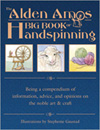 |
Publisher |
Loveland, CO: Interweave
Press, 2001. |
| Status |
In print |
  |
| Alden Amos’
book is indeed big! He covers all
the basics: preparing both animal
and plant fibers, learning to
spin on a wheel, mastering various
drafting styles, plying, and finishing
your yarn. He also covers many
(many!) not-so-basics: making
punis, retting flax, creating
your own spinning tools. Even
the most experienced spinners
will learn something here. If
you work your way through this
volume, you will gain a huge amount
of spinning knowledge, but beginners
who require a more visual, step-by-step
approach might do well to use
this book as an adjunct. Illustrations
are limited to black-and-white
line drawings. No (textile) project
instructions per se, but Amos
includes detailed technical drawings
for those who want to build their
own tools (including spindles,
reels, and tools for flax preparation). |
| Baines,
Patricia. Linen:
Handspinning and Weaving |
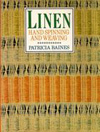 |
Publisher |
London: B.T. Batsford,
Ltd., 1989. Reprint, Loveland, CO:
Interweave Press, 1990. |
| Status |
Out of print, available but expensive |
     |
| Patricia Baines’s
book covers pretty much everything
you could ever want to know about
growing, harvesting, processing,
spinning, and weaving with linen—with
a healthy dose of history added
for good measure. The text is technical,
well written, and interesting, but
geared toward readers with intermediate
spinning and weaving experience.
Fully illustrated with black-and-white
photos and line drawings. It’s
a shame this is out of print because
this book should be on the shelf
of all serious plant-fiberistas.
The author has a small 32-page chapbook
in print, Flax and Linen, which
gives a brief overview of linen
cultivation and processing. |
| Baines,
Patricia. Spinning
Wheels, Spinners, and Spinning |
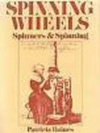 |
Publisher |
London, B.T. Batsford,
Ltd., 1977. Reprint, 1991. |
| Status |
Out of print, but available used |
 |
| Although this book
includes a short how-to section
in the back, it is primarily a history
of spinning from a European perspective,
with a special emphasis on the development
of the spinning wheel. Illustrations
are all in black and white, and
include photos, engravings, and
line drawings. Spinners with an
interest in history will want to
grab a copy of this book before
it becomes rare! |
| Barber, Elizabeth
Wayland. Women’s
Work: The First 20,000 Years; Women,
Cloth, and Society in Early Times |
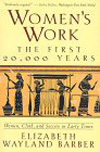 |
Publisher |
New York: W. W. Norton
and Company, 1994. |
| Status |
In print |
 |
| For millennia, to
be a woman was to be a spinner.
When we sit at our wheels or pick
up our spindles, we take part in
a ritual that goes back to the beginnings
of human life. If that idea intrigues
or moves you, you’ll enjoy
this book, which covers textile
work from the Paleolithic to the
Iron Age. The fact that the author
is herself a weaver makes this historical
account all the richer. |
| Boeger, Lexie. Intertwined:
The Art of Handspun Yarn, Modern
Patterns, and Creative Spinning. |
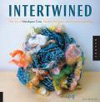 |
Publisher |
Beverly,
Massachusetts: Quarry Books, 2008. |
| Status |
In print |
   |
| Intertwined is the
standard resource for art yarn spinner.
As a spinning technique book, this
has 28 different art yarn techniques,
each with clear color illustrations.
For spinners who like a little inspiration
with their spinning, this book is
packed full: a design journal from
Boeger taking a few projects from
fiber to finished accessory, a discussion
on inspiration both external and
internal, and profiles of three
artists working the art yarn medium.
There are also 30 patterns using
art yarns -- some knit, some crochet,
some woven, some felted. There is
no other book that touches this
one for spinning, using, or even
thinking about art yarn. |
| Buchanan,
Rita. A Weaver’s Garden |
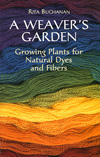 |
Publisher |
Loveland, CO: Interweave
Press, 1987.
Reprint, New York:
Dover Publications, 1999. |
| Status |
In print, plus 1987 edition is
widely available used |
 |
A Weaver’s
Garden is not a how-to-spin
book per se, but it belongs on
the shelf of every spinner. It
is a treasury of traditional knowledge
that has been tested by a modern
fiber artist. Rita Buchanan, whose
name will be familiar to long-time Spin-Off readers,
is not only an amazingly talented
and knowledgeable spinner, knitter,
and weaver, but she also holds
degrees in botany and has spent
years exploring the world of plants
from a fiber artist’s perspective.
The book covers the use of plants
for spinning and dyeing as well
as the use of plants for making
natural soaps, moth repellants,
and textile tools. There is also
a great section on designing your
own “spinner’s” garden.
Beautiful drawings by the author’s
husband and a color insert illustrate
the text.
A shorter,
full-color version of the chapter
on dye plants was published as
a separate book (and is still
in print) by Interweave Press: A Dyer’s Garden:
From Plant to Pot, Growing Dyes for Natural Fibers. The
majority of the material is
covered in A Weaver’s Garden, but
it’s
worth having both books anyway. The full-color photographs of dye samples
make A Dyer’s Garden a
great supplement to the more complete
text. |
| Casey,
Maggie. Start Spinning: Everything
You Need to Know to Make Great Yarn |
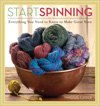 |
Publisher |
Loveland, CO: Interweave
Press, 2008. |
| Status |
In print |
 |
A fantastic
introduction to the skill of spinning,
this book really does cover everything
you need to know. Choosing fiber,
hand- and drumcarding, learning
to spin on both spindle and wheel,
developing your drafting skills,
finishing and using your own yarn — it’s
all in here along with clear,
full-color photographs. The author
provides solid guidance for using
your new handspun in knitting
or weaving projects of your choice. |
| Chadwick,
Eileen. The
Craft of Hand Spinning |
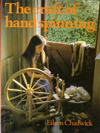 |
Publisher |
New York:
Charles Scribner, 1980 |
| Status |
Out of print |
  |
Another
good all-around book, definitely
worth the hunt to find it used.
The standouts for this one are
the photography which is copious
and large, all in B&W
and very informative. There's
discussion on spinning fibers
other than wool -- silk, alpaca,
qivuit, mohair, dog hair, and
a large section on flax and cotton,
all rarely found in older books. |
| Clark-Moore,
Amy (editor). All
New Homespun Handknit: 25 Small Projects
to Knit with Handspun Yarn. |
 |
Publisher |
Loveland,
CO: Interweave Press: 2009. |
| Status |
In print |
 |
Kathryn
Alexander, Amy King, Sara Lamb, Nancy
Bush, Judith MacKenzie McCuin and
many other spinning and knitting
glitterati contributed to an updated
version of the classic Homespun,
Handknit.
Similar to the original: all the
projects are small accessories and
children’s projects, all the
projects are made from handspun yarn
with enough information to substitute
with commercial yarn. Different from
the original: the projects are for
intermediate+ knitters; the projects
span a wide range of knitting techniques
-- a variety of colorwork, texture
and lace. |
| Claydon,
Jennifer. Spin,
Dye, Stitch: How to Create and Use
Your Own Yarns |
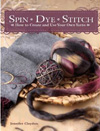 |
Publisher |
Cincinnati, OH:
North Lights Books: 2009 |
| Status |
In print |
 |
This is
a very basic spinning and dyeing
book, with 10 projects to use your
new yarn. If you are curious about
making and dyeing your own yarn,
this book gives a good overview for
those new to the craft. |
| Daykin,
Alison and Deane, Jane. Creative
Spinning |
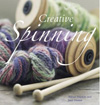 |
Publisher |
New York:
Lark Books, 2007 |
| Status |
In print |
  |
A book
for inspiration. There is basic information
on how to spin on a wheel and spindle,
as well as brief instruction on different
art yarn techniques. The techniques
instruction is so concise that it's
more of a reminder for those who
already have spinning knowledge than
instruction for those looking to
begin spinning.
The majority of the
book contains projects to spin a particular
style of yarn with a particular type
of wool. The inspiration portion
of the book comes with the unbelievable
photography. The photographs of yarn
and fiber in this book set the standard
of what all spinning book photography
should be, clear, detailed and sumptuous.
Each project yarn features four photographs:
an image that inspired the project
yarn, project fiber, spun yarn and
the yarn knit in stockinette stitch. |
| Delany,
Connie. Spindle Spinning: From
Novice to Expert |
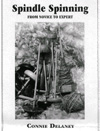 |
Publisher |
Lexington, KY: Kokovoko
Press, 1998 |
| Status |
Self-published, new and used copies
available |
 |
Spindle
Spinning is one of the few
books we have that is completely
devoted to spindling. The author
covers top- and bottom-whorl spindles,
the Navajo spindle, and supported
spindle. The sections on fiber
prep are very brief, and the book’s
focus is primarily developing the
techniques you’ll need to
become a successful spindler. Illustrations
are primarily line drawings, but
the text is clear and easy to follow. |
| Dun,
Katherine. Beautiful Sheep: Portraits
of Champion Breeds |
 |
Publisher |
New York:
Thomas Dunne Books, 2008. |
| Status |
In print |
 |
40 breeds
of sheep all magnificently photographed
in a studio against a plain draped
background. If you have ever wanted
to get a good look at the animals
that provide your wool, this is the
book for you.
The descriptions of
the sheep breeds are not specifically
geared to spinners; there are discussions
on breed features, breed use, related
breeds, breed size and origin and
distribution of each breed. There
is no discussion of fleece classification,
staple length, or anything that informs
about spinning with a particular
breed. |
| Fannin,
Allen. Handspinning: Art and Technique |
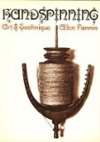 |
Publisher |
New York: Van Nostrand
Reinhold, 1970. |
| Status |
Out of print, but available used |
   |
This book
will be of more interest to those
who have been spinning a while, especially
those who are curious about handspinning’s
first renaissance during the 1960s
and 70s. The late Allen Fannin was
a central player in rediscovering
and reinventing spinning techniques.
His book, which covers woolen and
worsted prep and spinning styles
as well as “designer” yarns
(a new concept at the time) is all
the more amazing when you learn that
he was self-taught. There are newer,
shiner books with color
photos, but I’m not sure there
is anything more complete: spindle
spinning, low and great wheel spinning,
and yarn design are all covered.
The writing style of Handspinning is
highly technical, but even experienced
spinners will find something to learn
here. |
| Field,
Anne. The
Ashford Book of Spinning |
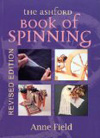 |
Publisher |
Ashville,
NC: Lark Books, 1986
2nd edition Christchurch,
New Zealand: Shoal Bay Press 1999 |
| Status |
Out of print, but available used |
 |
From its
publication date until very recently,
this book was the go-to book for
new wheel spinners -- the book that
shops and teachers recommended.
It's still one of the top two books
for new spinners.
It goes into great
detail with photographs and illustrations
on the beginning aspects of spinning:
fiber, drafting, plying. Field further
discusses fleeces prepping, washing,
carding, combing, spinning techniques,
novelty yarn, dyeing, felting as
well as a question and answer section
from her years of teaching. There
is a huge amount of information in
this slim book. It should be in every
spinner's library. |
| Field,
Anne. Spinning
Wool: Beyond the Basics |
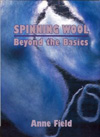 |
Publisher |
Christchurch,
New Zealand: Shoal Bay Press,
1995 |
| Status |
Out of print, but available used |
  |
For spinners
who have reached proficiency in basic
skills, often the next step is making
a specific yarn for a specific project.
This book is exactly for that level
of spinning. It picks up where Field’s The
Ashford Book of Spinning leaves
off. It discusses in detail, with
words and photos, controlling your
wheel, types of wool, carding, drafting
techniques, twist, ply and finishing.
It is not an exhaustive second step
for spinners, but it’s just
enough information to feed the curious
spinner without overwhelming. |
| Fournier,
Nola and Jane Fournier. In Sheep’s
Clothing: A Handspinner’s Guide
to Wool |
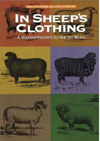 |
Publisher |
Loveland, CO: Interweave
Press, 1995. Reprint, 2003 |
| Status |
In print |
  |
This book
is the next best thing to taking
a workshop on selecting, sorting,
and using raw fleeces. Spinners who
are ready to learn about sheep breeds
and the unique characteristics of
their fleeces will find this the
perfect intro.
Black-and-white photos
of locks of wool for each breed covered
span the range from superfine to
coarse fibers. Readers will learn
about how textile professionals describe
and classify fibers by fineness,
and what all that means for handspinners
hoping to make yarns appropriate
for their projects. You’ll
never look at a sheep quite the same
way again! |
| Franquemont,
Abby. Respect the Spindle: Spin
Infinite Yarns with One Amazing Tool |
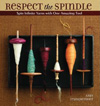 |
Publisher |
Loveland, CO: Interweave
Press, 2009 |
| Status |
In print |
 |
This book
is the ‘stranded on a desert
island’ spindle book. You
need no other. A lifetime of expertise
guides you from choosing equipment
and beginning spinning on spindles,
to mastery and significant output
on all types of spindles. No other
book has this level of information
on spindle spinning. |
| Gibson-Roberts,
Priscilla A. High Whorling: A
Spinner’s Guide to an Old World
Skill |
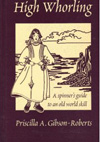 |
Publisher |
Cedaredge, CO: 1998. |
| Status |
OOP, with new and used copies available |
 |
In this
classic spinning book, Gibson-Roberts
makes her argument for the high-whorl
spindle’s superiority. If you
are a very beginning spinner and
a visual learner, you may need another
book for visual back up -- this book
has illustrations only and they are
few.
Agree or not about the high-whorl's
superiority, this is a fine book
of spinning instruction and spinning
history. The writing is personal
and engaging, told from the heart
and soul of one of the fiber world’s
living treasures. |
| Garripoli,
Amelia. Productive
Spindling |
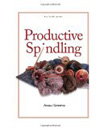 |
Publisher |
Port Angeles,
WA: Ask the Bellweather, 2009 |
| Status |
In print |
 |
This book
is not a splashy four-color book
from a big publisher, but it is a
book packed with great information
on spindle spinning, particularly
for the new spindle spinner. It covers top and bottom whorl, and Turkish
spindles.
The first half of the book is about choosing and using a spindle, the second
half on how to be productive. This is one of few books that treats spindle
spinning as a complete craft, not as spinning that you do until you can
afford a wheel. |
| Horne,
Beverley. Fleece in Your Hands:
Spinning with a Purpose, Notes and
Projects |
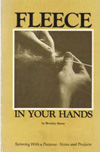 |
Publisher |
Revised edition, Loveland,
CO: Interweave Press, 1979. |
| Status |
OOP, but available used |
  |
Beverley
Horne’s book was
one of the first to explore the characteristics
of specific sheep breeds from a handspinner’s
perspective.
This is a small book
with line drawings and black-and-white
photos; the project instructions
would be considered sparse (and dated)
by today’s standards, but the
value of the book lies in her descriptions
of individual fleeces by breed and
recommendations for their use. Beginning
spinners will probably find the text
a bit dense going, but those who
are interested in learning how to
evaluate the raw fleeces offered
at fiber festivals will find lots
of helpful info here. |
| Irwin,
Bobbie. The
Spinner’s Companion |
 |
Publisher |
Loveland, CO: Interweave
Press, 2001. |
| Status |
In print |
 |
This spiral-bound
handbook is designed as a quick reference
to spinning terms and techniques — a
portable encyclopedia, if you will.
Can’t
remember how a single-band, flyer-lead
wheel works? Wondering what “thrown
silk” is? Bobbie Irwin has
catalogued the answers. Small black-and-white
line drawings illustrate concepts
as necessary. Both beginners and
more seasoned spinners will find
this a valuable reference. |
| King,
Amy. Spin Control: Techniques for
Spinning the Yarn You Want |
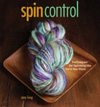 |
Publisher |
Loveland, CO: Interweave
Press, 2009 |
| Status |
In print |
   |
This book
aims to help advanced beginners and
more experienced spinners gain control
over the yarns they are producing.
Most of us learn to spin and then
comfortably settle into spinning
our “regular” yarn,
whatever that may be. Amy King challenges
spinners to become skilled enough
to master our fiber and to learn
to design a yarn in our minds before
creating it with our hands.
To that
end, the book offers detailed instruction
in choosing a fiber that will give
the effect we seek; understanding
wheel settings and how they affect
yarn production; perfecting drafting
techniques and styles and learning
to blend them; and designing standard
and novelty yarns. Fully illustrated
with color photographs. No projects
(the focus here is on theory). |
| Kluger,
Marilyn. The Joy of Spinning |
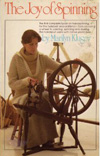 |
Publisher |
New York:
Henry Holt, 1991. |
| Status |
OOP, but available used |
  |
Written
in a conversational style, this book
is a wealth of information. It may
pale in spinning instruction compared
to new and flashier spinning books
that focus on the how-to of spinning.
This books comes from the era of
spinning books that was more holistic
in approach.
Here you have the whole
history of spinning from a personal
point of view, history of the people
who spun, what they spun, the equipment
they spun with, how they dyed their
yarns and fibers and what they made
with it all, interlaced with making
you the curious reader and spinner,
part of the continuum of spinning
history. |
| Kroll,
Carol. The Whole Craft of Spinning:
From the Raw Material to the Finished
Yarn |
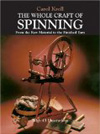 |
Publisher |
New York: Dover Publications,
1981. |
| Status |
In print |
 |
This is
really more of a booklet than a book,
but it is inexpensive and packed
with info for the beginning spinner.
Carol Kroll takes the novice from
choosing and preparing raw fiber
to spinning on a spindle and wheel.
The book’s major weakness from
today’s perspective is that
it contains few illustrations — just
a handful of black-and-white photos
supplemented by a few dozen line
drawings. But don’t dismiss
it out of hand (especially if you
find it used and cheap!): in spite
of its brevity, this book includes
fibers such as flax, ramie, corn
silk, milkweed floss, deer hair,
and numerous other folk materials
that the author has researched. |
| Ligon,
Linda, ed. Homespun, Handknit:
Caps, Socks, Mittens, and Gloves |
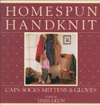 |
Publisher |
Loveland, CO: Interweave
Press, 1987 |
| Status |
OOP, but available used |
 |
Homespun,
Handknit is
rather unusual in that it’s
a book of small projects all designed
specifically for handspun yarn. Classic
designs — from
folks like Elizabeth Zimmermann,
Meg Swansen, Priscilla Gibson-Roberts
and Carol Rhoades, just to name a
few — make
this book as useful today as it was
twenty years ago. Projects range
from simple to advanced, and all
are illustrated with color photos.
The photostyling is a bit dated by
today’s standards,
but the patterns themselves have
stood the test of time. |
| Linder,
Olive and Harry. Handspinning Flax |
 |
Publisher |
Phoenix: Bizarre Butterfly
Publishing, 1986 |
| Status |
OOP, but available used |
  |
The Linders
offer a friendly intro to flax spinning
suitable for beginners who have mastered
the basics. Their instructions begin
with ready-to-spin line flax and
black-and-white line drawings illustrating
ways to dress a distaff. Plying,
finishing, and using handspun linen
yarns are covered, but the book includes
no projects. The Linders are generally
credited with unventing [to borrow
Elizabeth Zimmermann's
term and assumption that we are all
rediscovering forgotten fiber methodologies]
the no-distaff approach to linen
spinning. |
| Lloyd,
Lisa. A Fine Fleece: Knitting
with Handspun Yarns |
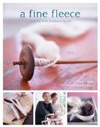 |
Publisher |
New York:
Potter Craft, 2008 |
| Status |
In print |
 |
This is
a book full of drop-dead gorgeous
cable knitting patterns. There are
26 patterns, mostly sweaters, all
knit in handspun yarn and commercial
yarn in classic styles begging to
become your family’s
heirlooms.
A chapter on handspinning
with information on wool, sheep breeds
and yarns is mostly for the uninitiated. |
| McCuin,
Judith MacKenzie. The Intentional
Spinner: A Holistic Approach to Making
Yarn |
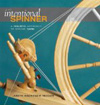 |
Publisher |
Loveland, CO: Interweave
Press, 2009 |
| Status |
In print |
   |
McCuin
assumes the reader is already a capable
spinner, and intermediate and advanced
spinners will find much to enhance
their practices in this book. Adventurous
and motivated advanced beginners
can also tackle the information,
although they may need to consult
other volumes for definitions and
extra help.
This book is fully illustrated
with color photographs throughout
and covers its subject in great detail:
the nature and qualities of a full
range of fibers, advanced fiber preparation
(including combing), and drafting
techniques. A chapter also covers
plying, cabling, and novelty yarns.
The approach is a bit eclectic rather
than encyclopedic, but the overall
effect is that of taking an advanced
workshop from a expert textile artist. The
four projects (both knitted and woven)
are designed to practice spinning
theories she has covered in the text. |
| McCuin,
Judith MacKenzie. Teach Yourself
Visually Handspinning |
 |
Publisher |
Hoboken, NJ
Wiley Publishing, Incorporated,
2007 |
| Status |
In print |
 |
A beginner’s
guide to spinning both on spindle
and wheel. This book gives an overview
of fiber and equipment and the how-to
of putting it all together. A solid
beginner’s book.
If you already
know how to spin you should move
to McCuin’s next book, The
Intentional Spinner. |
| Menz,
Deb. Color in Spinning |
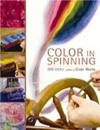 |
Publisher |
Loveland,
CO: Interweave Press, 1998, 2005 |
| Status |
In print |
  |
This
is one of those books that should
be on the bookshelf of every spinner.
It is a detailed course in color
theory for handspinners — this
short entry can’t even
begin to convey the knowledge
packed into this text.
Menz
covers dyeing and painting fibers,
using combs and drum carders
to blend colors, and spinning
from multicolored preparations.
Fully illustrated with black-and-white
and color photographs and line
drawings. In spite of the highly
technical level of the text,
Menz’s tone is clear and
helpful. I’ve given this
a two-spindle level rating because
it’s helpful to understand
spinning and fiber prep basics
before reading this book. |
| Okey,
Shannon. Spin to Knit: The Knitter’s
Guide to Making Yarn |
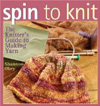 |
Publisher |
Loveland, CO: Interweave
Press, 2006 |
| Status |
In print |
 |
Shannon
Okey approaches learning to spin
with the eye of a knitter who
wants to produce some yarn pronto!
She briefly covers fiber acquisition
and preparation, spinning on spindles
and wheels, yarn finishing — and
then jumps right into the knitting.
Numerous small projects make
use of beginner’s yarn.
Full-color photographs illustrate
the spinning process step-by-step
as well as projects, and profiles
of spinners from all over the
U.S. provide inspiration. This
book will appeal to knitters
who want to experiment with
spinning without making a huge
investment of time and money. |
| Raven,
Lee. Hands on Spinning |
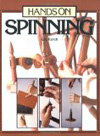 |
Publisher |
Loveland, CO: Interweave
Press, 1987 |
| Status |
In print |
 |
Lee
Raven’s classic learn-to-spin
text has stood the test of time:
it’s as useful today as
it was when it was first published.
She includes spinning on a hand
spindle as well as a wheel and
takes you all the way from preparing
fiber to learning different drafting
methods and yarn finishing techniques.
The book covers spinning strategies
for numerous animal and plant
fibers and includes plenty of
hints for troubleshooting. The
text is illustrated with black-and-white
photos and line drawings; project
photos appear in color. The projects
[several knitted, with one woven]
are perhaps a bit rustic but will
give you ideas for what to do
with the fruits of your first
spinning efforts. |
| Robson,
Deborah, editor. Handspun
Treasures from Rare Wools: Collected
Works from the
Save the Sheep Project |
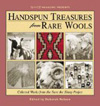 |
Publisher |
Loveland, CO: Interweave
Press, 2000. |
| Status |
Out of print, but available used |
 |
Sponsored
by Spin•Off magazine and
the American Livestock Breeds
Conservancy, the Save the Sheep
project was created to promote
understanding about rare sheep
breeds within and beyond the spinning
community.
This book is the catalog
of the touring exhibit, Save
the Sheep, featuring
29 projects made from wool produced
by rare and endangered sheep
breeds. The projects, some knitted,
some woven, some mixed media
art pieces have been photographed
in a studio and discussed at
length. There are photos and
descriptions of 21 rare sheep
breeds and essays on how a breed
becomes endangered, the history
of handspinning, and spinning
for expression. This was and
is an important project that
involved many spinners and sheep
experts from around the world;
the contributors acknowledgments
is a list over 200 people long. |
| Ross,
Mabel. Encyclopedia of Handspinning |
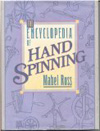 |
Publisher |
Loveland,
CO: Interweave Press, 1988. |
| Status |
Out of print, but available used |
 |
A wonderful
reference for all handspinners.
With detailed illustrations, photographs
and comprehensive entries on all
aspects of handspinning from sheep
breeds and other spinnable fibers,
to technique, to equipment --
modern and ancient -- this book
gives an overview of spinning
like no other. |
| Ross,
Mabel. The Essentials of Handspinning |
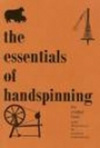 |
Publisher |
Wellingborough,
Northants: Brett Associates,
1980 |
| Status |
In print |
 |
A
40-page booklet with just the
quick facts for spinning on a
wheel or spindle. There’s
just enough solid information
to get you started, help you tweak
your yarn, and spot and fix potential
problems. |
| Simmons,
Paula. Spinning and Weaving with
Wool |
 |
Publisher |
Seattle,
WA: Pacific Search Press, 1977 |
| Status |
Out of print |
  |
Thorough
beginning spinning information
from the great Paula Simmons.
Two of the most useful spinning
chapters are Conquering Overtwist
and Spinning for Speed, which
when expanded became Spinning for Softness and Speed.
There is a very thorough chapter on great wheel spinning. You can take
a peek into the recent spinning past in the chapter that is a catalog for
spinning wheels available in the year this book was published. In her ‘why
not do it yourself’ style, there are even plans to make hand cards,
a drum carder, a yarn blocker, a floor reel and a basic spinning wheel. |
| Spin-Off
Magazine. A
Handspindle Treasury: 20 Years
of Spinning Wisdom from Spin-Off
Magazine |
 |
Publisher |
Loveland, CO: Interweave
Press, 2000 |
| Status |
In print |
  |
Reprints
of handspindling articles from
Spin•Off magazines, many out of
print. Fascinating reading for the spindle obsessed. For those of you who
dismiss much of this as outdated, I argue that our near history is as important
as our ancient history. |
| Stove,
Margaret. Merino:
Handspinning, Dyeing, and Working
with Merino and Superfine Wools |
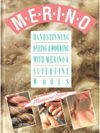 |
Publisher |
Loveland, CO: Interweave
Press, 1991 |
| Status |
OOP, but available used |
     |
Margaret
Stove’s Merino is
essentially a textbook for advanced
spinners who are interested in
taking on the challenge of spinning
with superfine wools.
She covers
the subject in great depth, including
washing and preparing the fiber,
spinning and plying techniques
specifically for fine wools, and
dyeing information. The author
is a seasoned spinning mentor,
and she explains her methods in
detail. Appendices offer instructions
for a few projects appropriate
for superfine wools. Diagrams,
black-and-white photos, and a
few color photos illustrate Margaret’s
techniques. |
| Tapper,
Joan. Shear Spirit: Ten Fiber
Farms, Twenty Patterns, and Miles
of Yarn |
 |
Publisher |
New York:
Potter Craft, 2008 |
| Status |
In print |
 |
Small
fiber farms are the backbone of
the spinning world. They are thought
of with reverence for the quality and their unique fiber and yarn.
This
book visits 10 fiber farms across
the US with two patterns knit
from handspun or millspun yarns
from each farm. The phenomenal
photographs tell the stories of
the families and the animals and
their connection to each other
and the fiber we all love. |
| Teal, Peter. Hand
Woolcombing and Spinning: A Guide to Worsteds from the Spinning-Wheel |
 |
Publisher |
Blandford Press: Poole, 1976.
Reprint, McMinnville, OR: Robin and Russ Handweavers, Inc., 1993 |
| Status |
OOP, but readily available used |
     |
Peter Teal’s book on worsted spinning is highly
technical and complete.
He covers the entire process of creating
worsted-style yarns from choosing, sorting, and scouring fleece
to combing and spinning. He even includes instructions for making
English-style wool combs for the adventurous. Illustrations are
primarily black-and-white photos and line drawings, but there is
a color insert in the center. The book focuses on technique and
does not offer projects or designs. Overall, this is a book for
serious spinners who want to explore worsted spinning in depth. |
| Ulrich,
Laurel Thatcher. The Age of
Homespun: Objects and Stories in
the Creation of an American Myth |
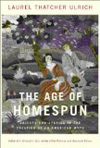 |
Publisher |
New York: Alfred
A. Knopf, 2001 |
| Status |
In print |
 |
The Age of Homespun is
an academic book, but a very readable
one. It is not a how-to by any
means, but spinners with an interest
in their history will find it
fascinating since textiles play
a major role in the text.
The
long-standing myth referred to
in the subtitle is that individual
American households were self-sufficient
cloth-producing factories from
the colonial period to some time
in the nineteenth century. Laurel
Ulrich unpacks the many stories
embodied in this myth, and in
the process, reveals to us the
lives of ordinary women and men. |
| Varney,
Diane. Spinning Designer Yarns |
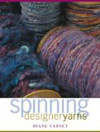 |
Publisher |
Loveland, CO: Interweave
Press, 2003 |
| Status |
In print |
   |
Originally
published in 1987 and reissued
in 2003, this book used to be
the only book available on art
or designer yarns.
Only half of
the book is devoted to actual
spinning techniques of designer
yarn. The rest of the book is
about planning and preparation,
being able to control your yarn
(this is not a book for beginning
spinners), color including dyeing
and fiber blending; really designing
your designer yarn. The spinning
portion is heavy on words and
light on illustration -- not great
for visual learners. This is,
however, a fine book for those
spinners who very much like to
think and plan their yarns before
spinning. |
| Vogel,
Lynne. The Twisted Sisters
Sock Workbook |
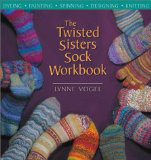 |
Publisher |
Loveland, CO: Interweave
Press, 2002 |
| Status |
In print |
  |
This
book walks you through designing
your own socks, dyeing and spinning
your own yarn. It is assumed you
have basic knowledge in spinning.
The discussion on color in spinning
is the heart and soul of this
book. There is great information
on preparing your roving before
spinning to achieve different
color effects in your yarn and
how different spinning techniques
-- number of plies and how colors
are plied -- affect knitted fabric.
There is even time spent with
Kathryn Alexander’s ideas
about energized singles.
The book is filled with photographs
explained with copious notes.
If you have interest in color,
even if you are not a sock fan,
this book has useful hands-on
information. |
|

